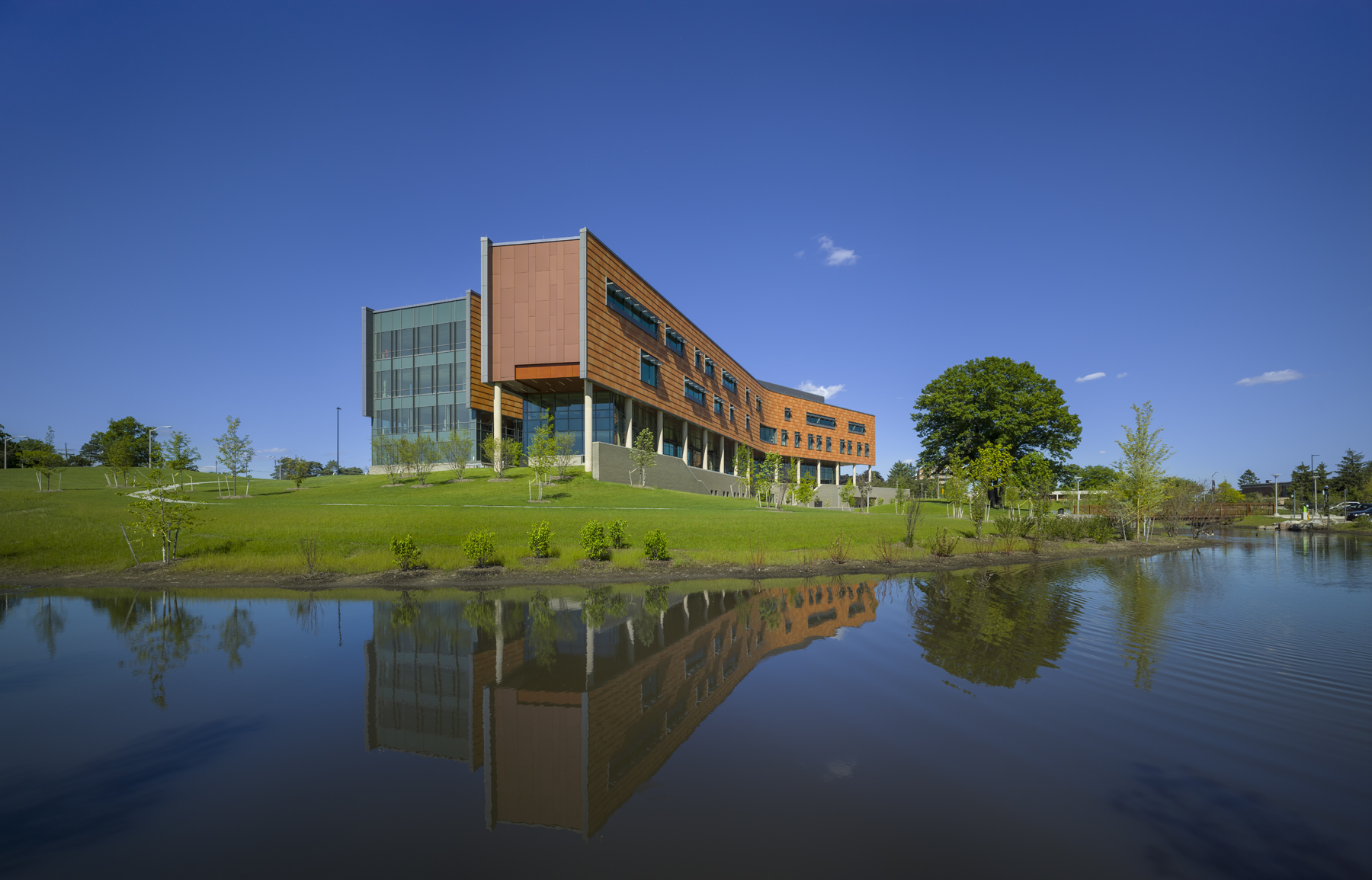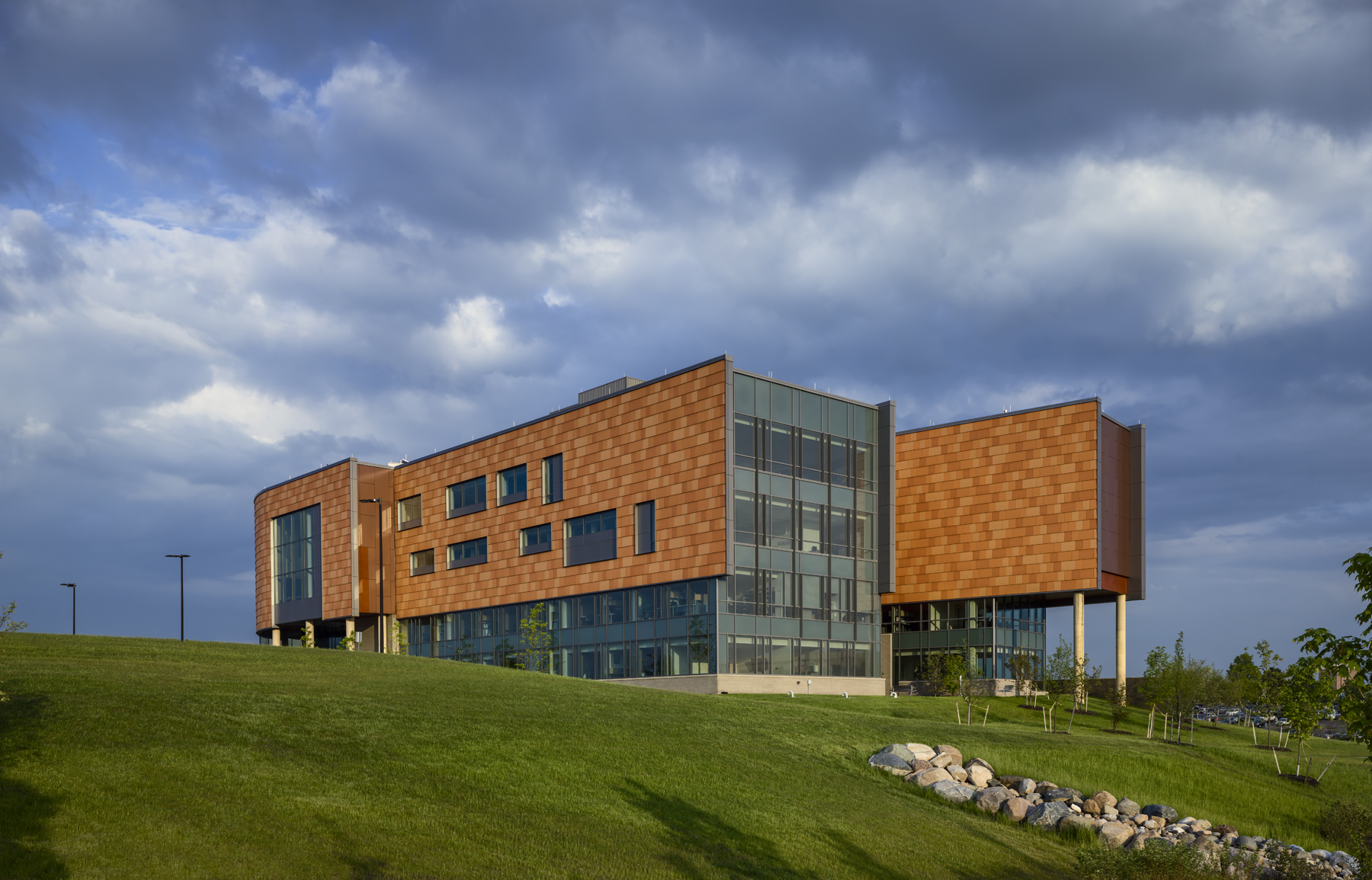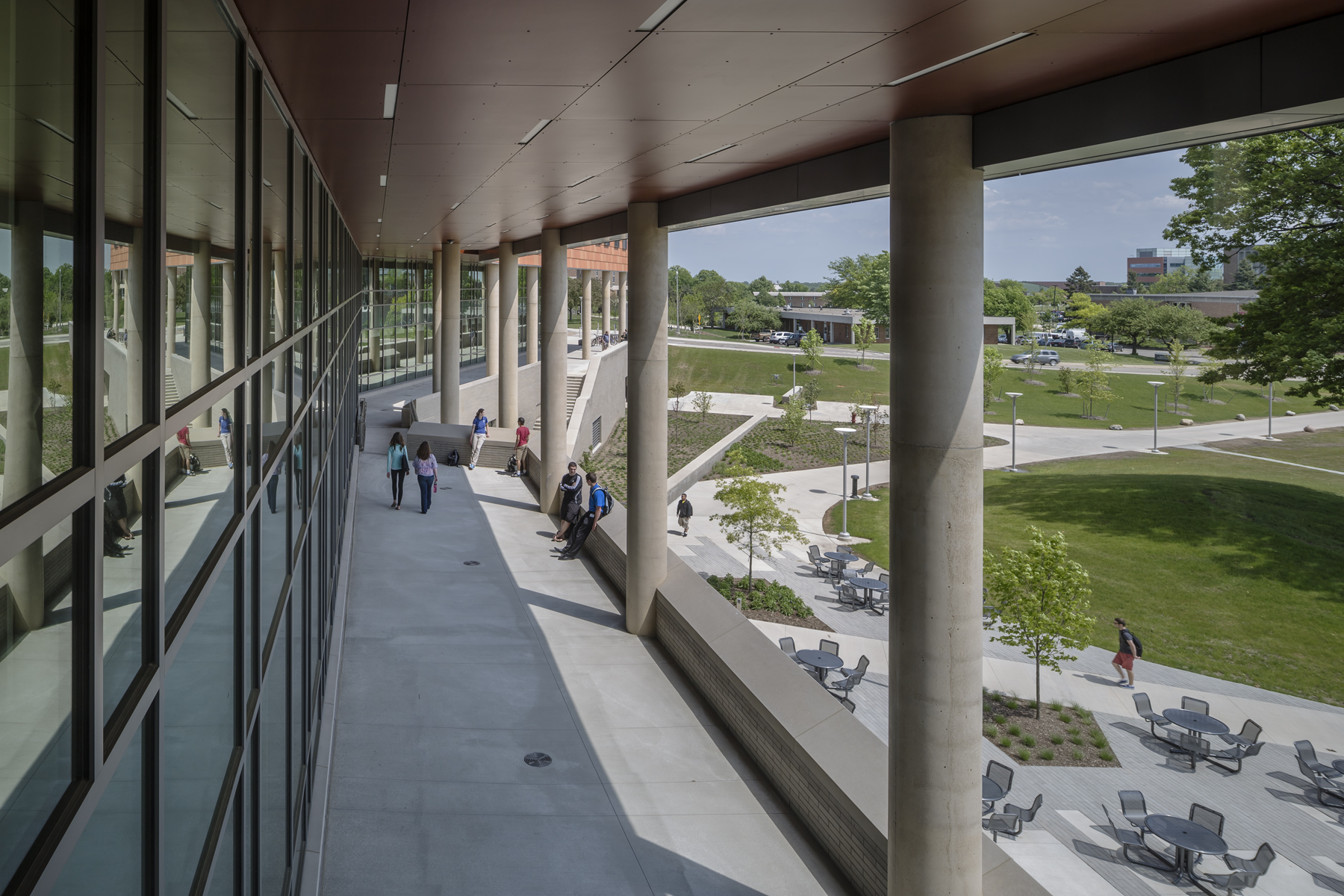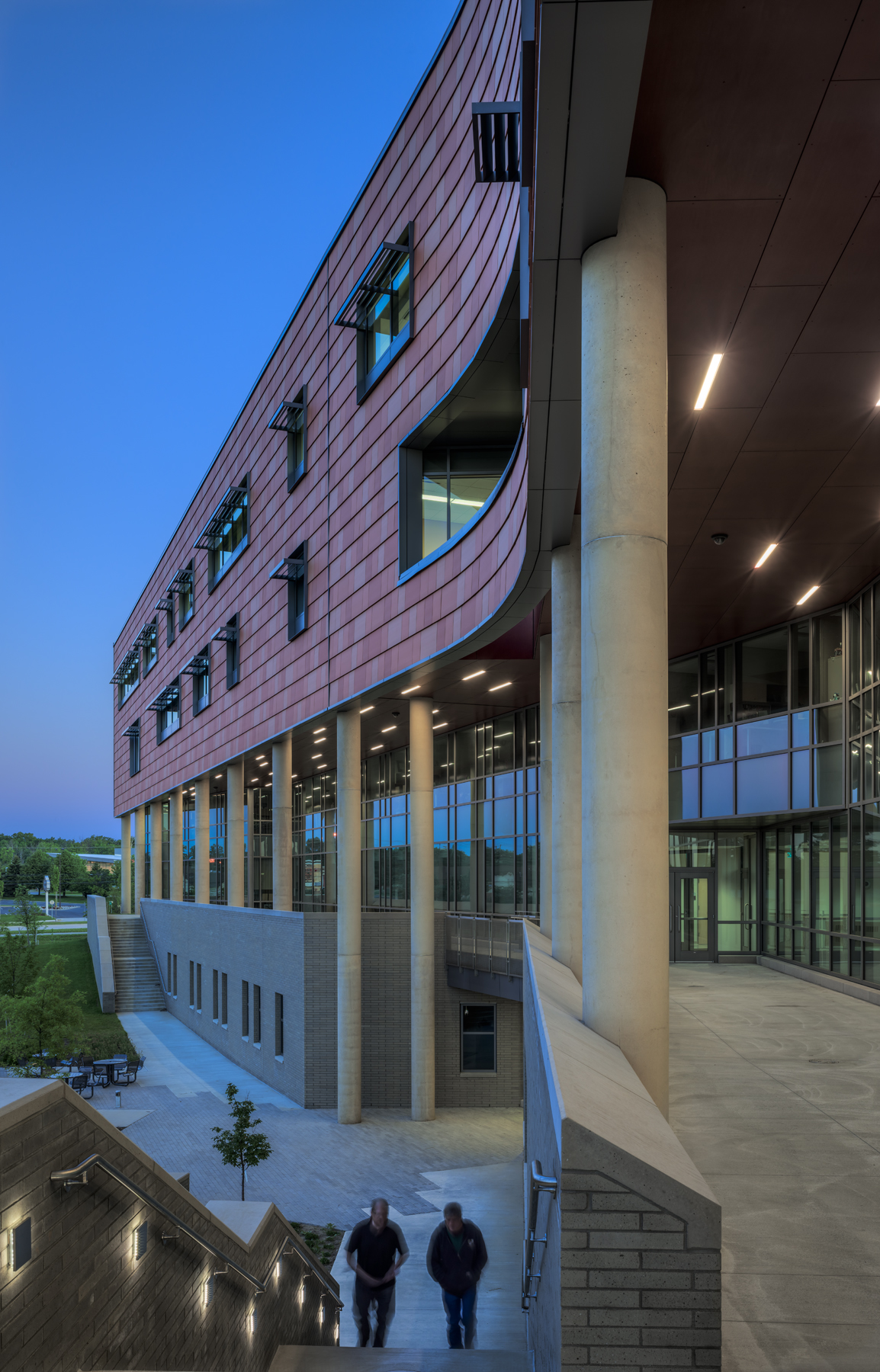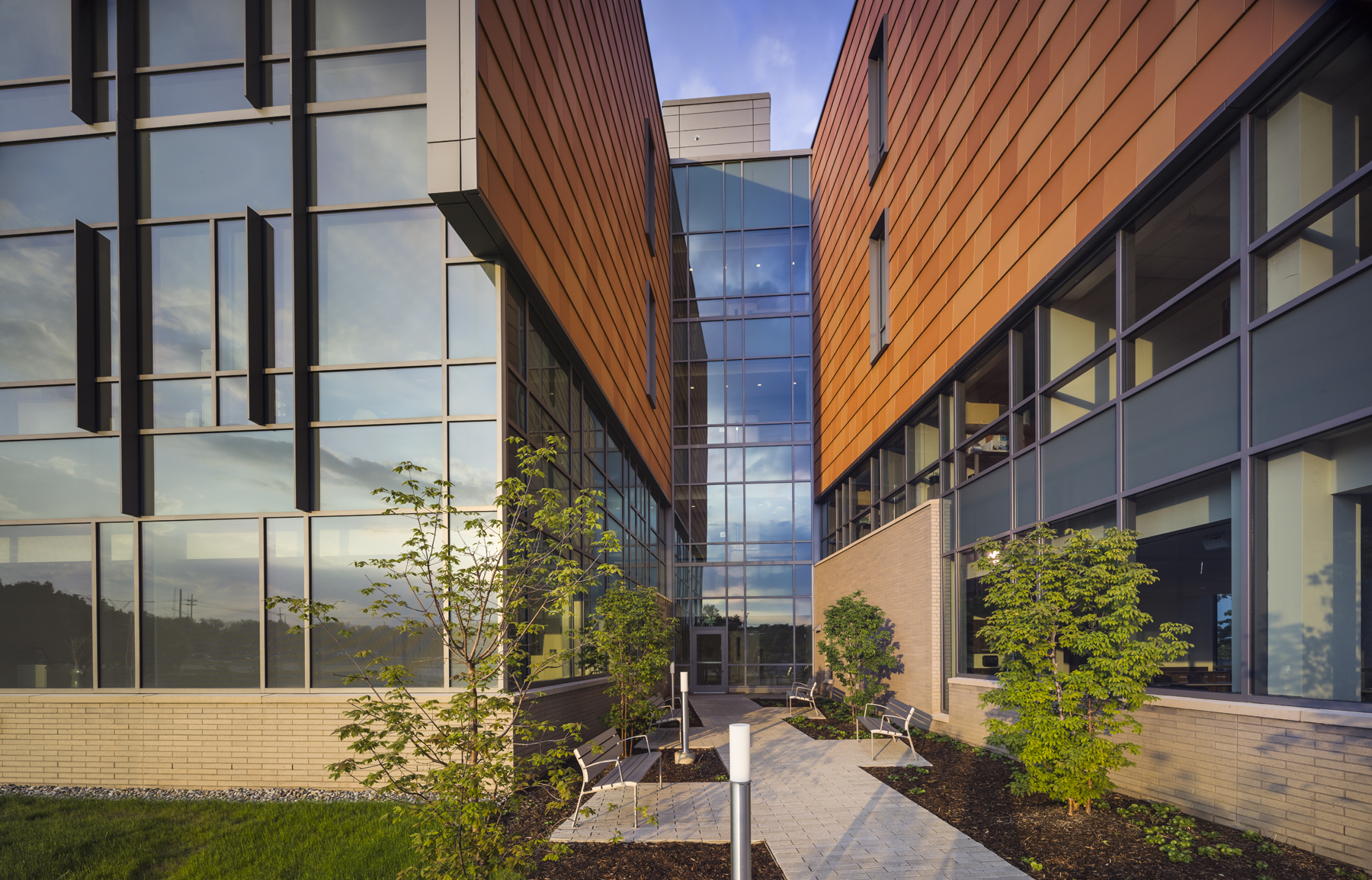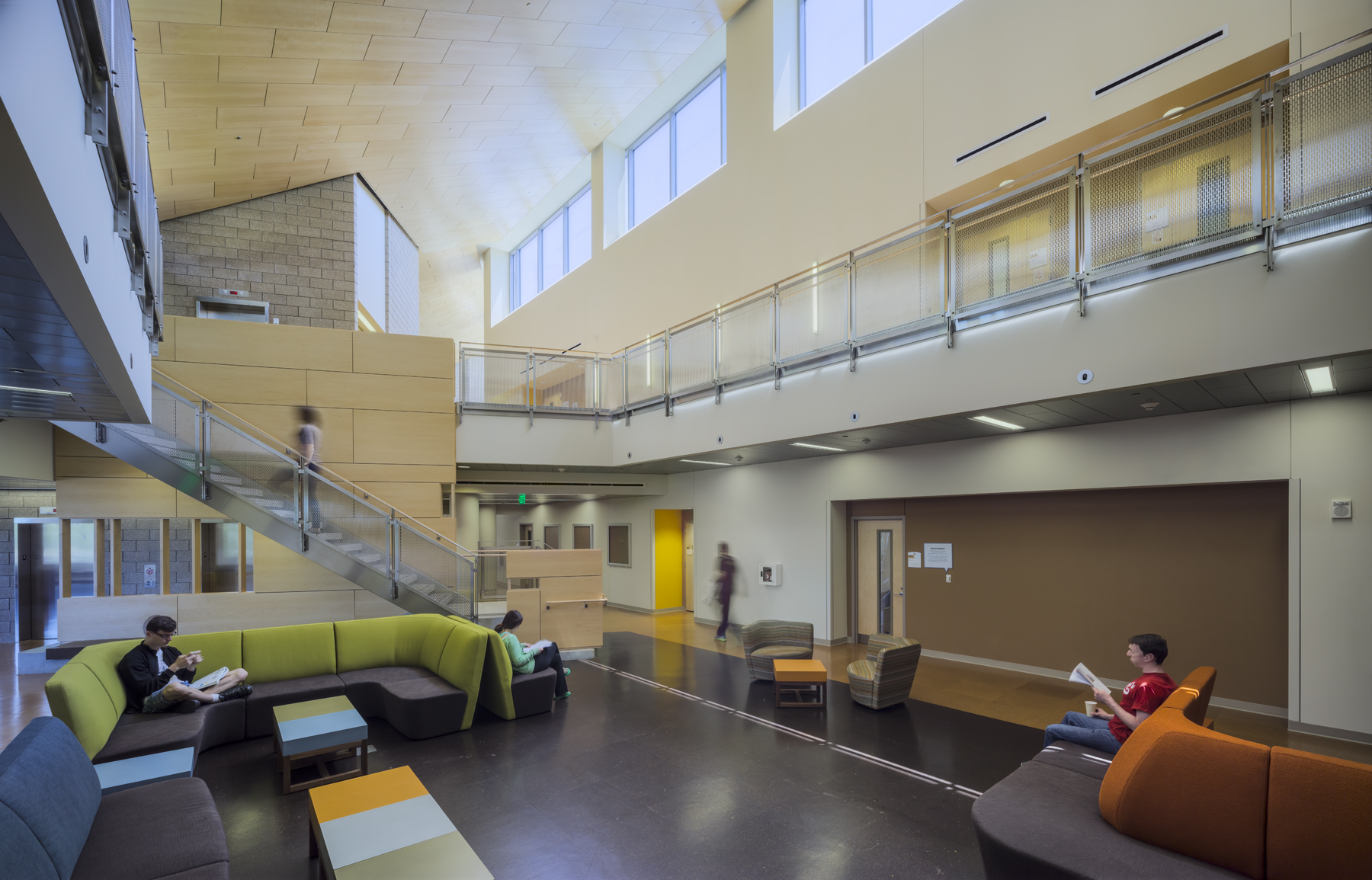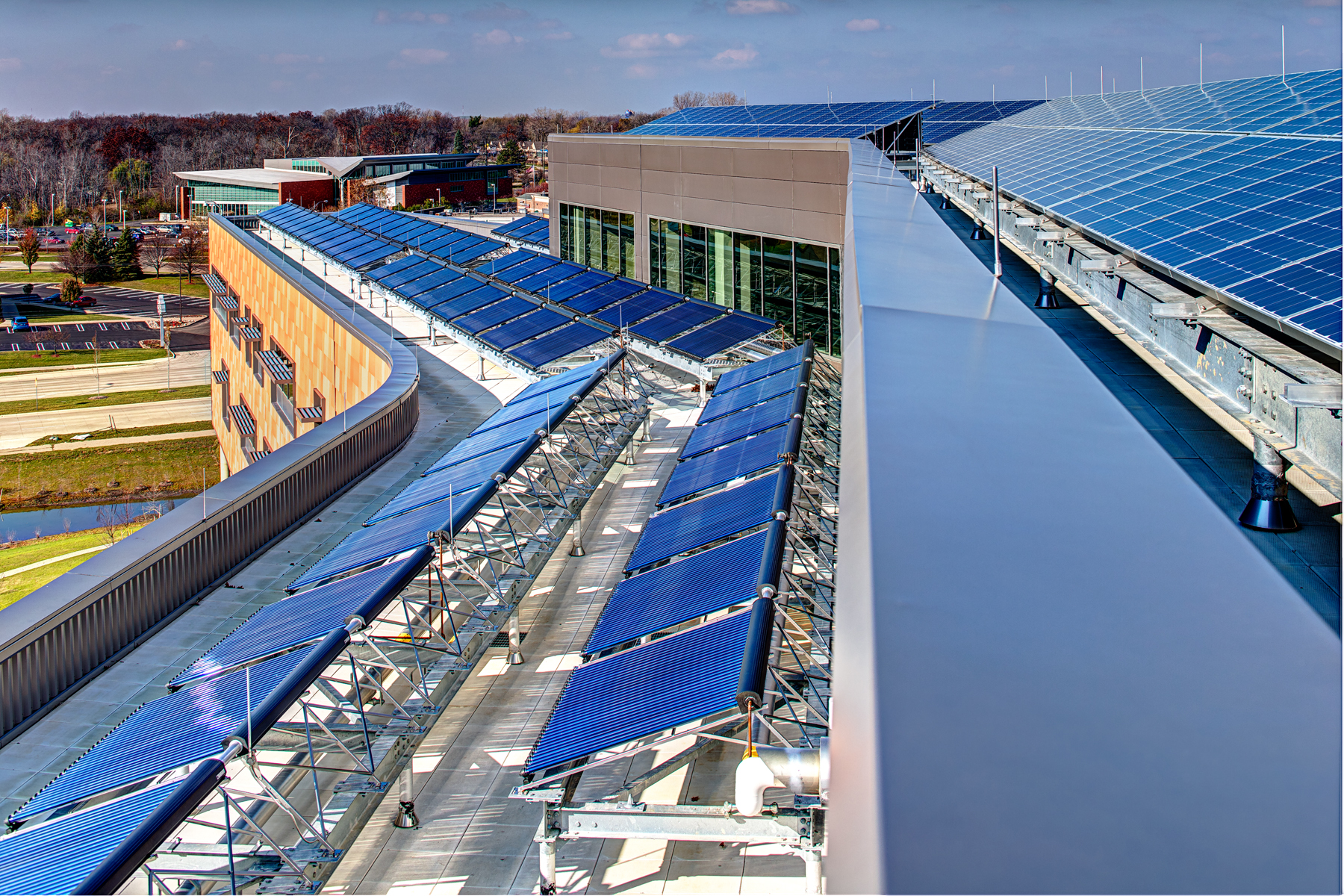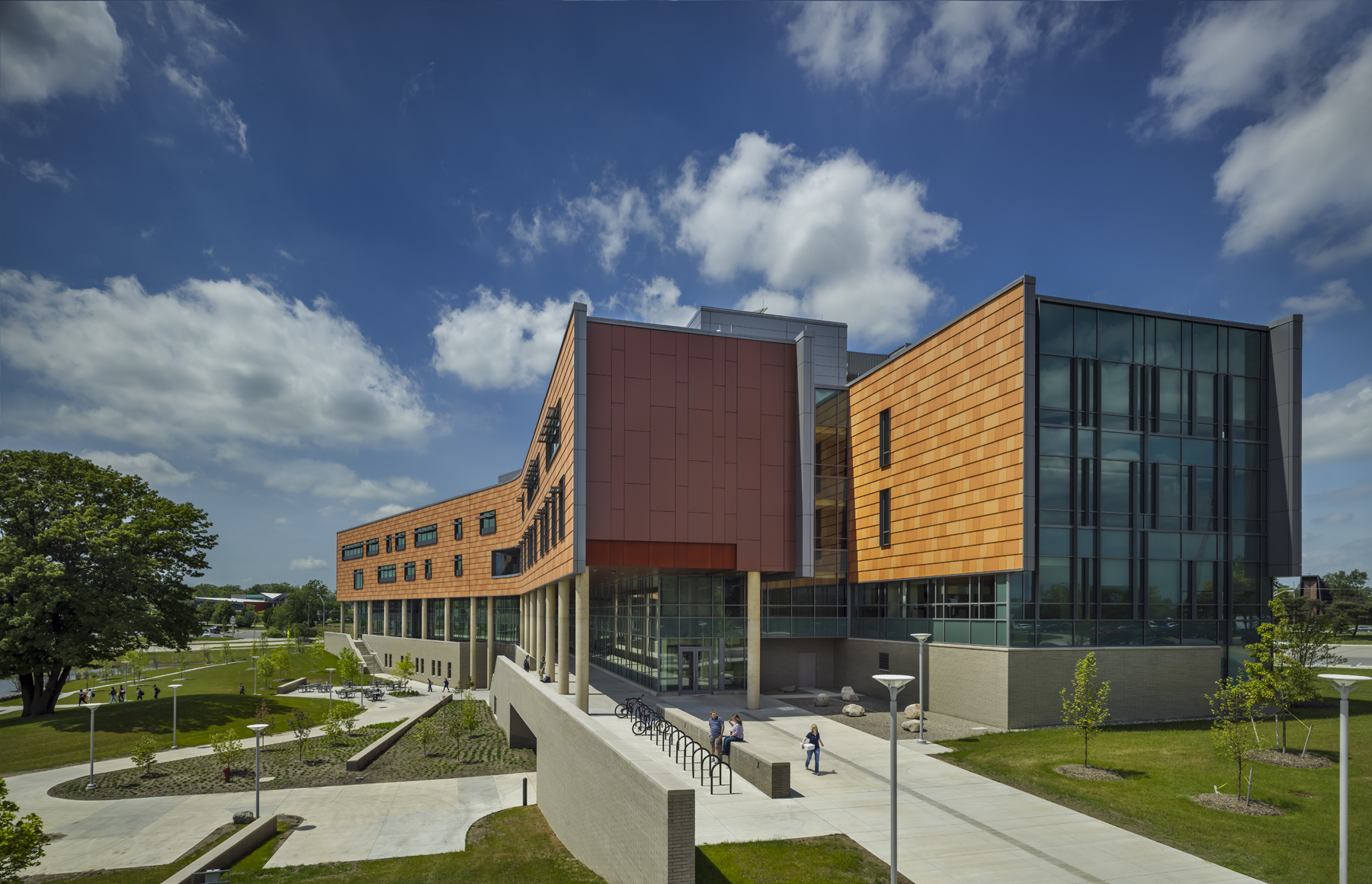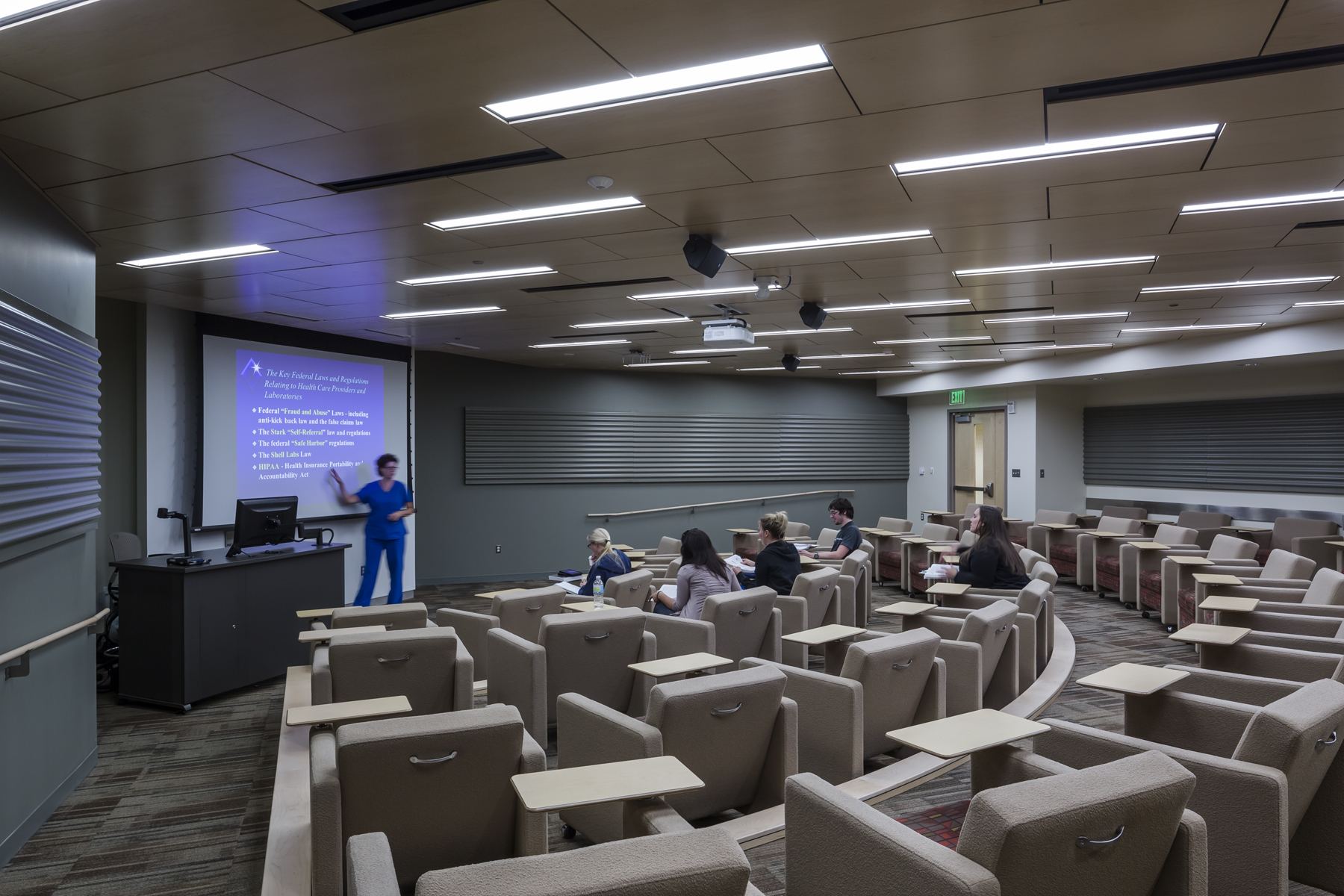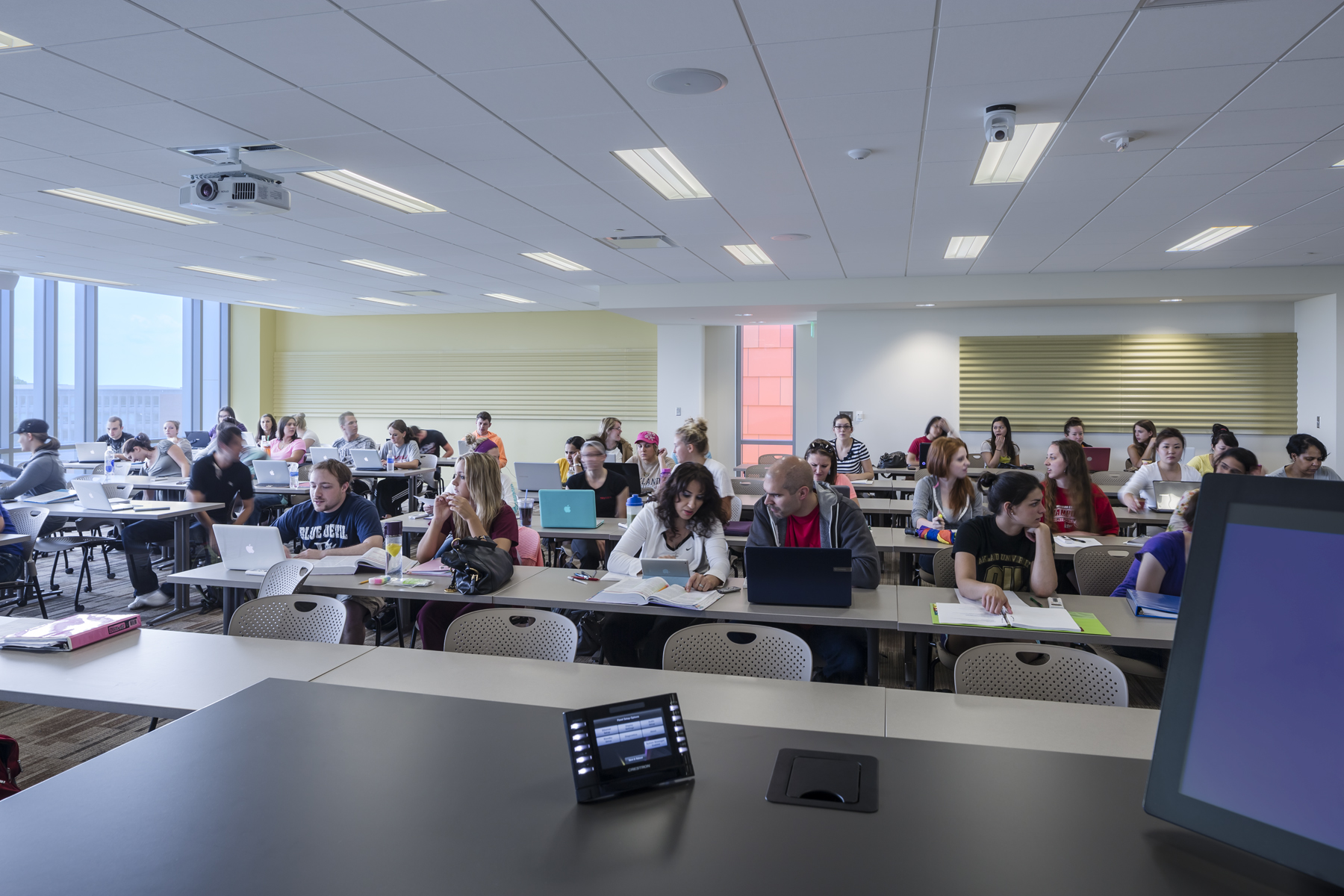The new $64 million Oakland University Human Health Building has become the first LEED Platinum certified building on a university campus in Michigan.
Designed by SmithGroupJJR, the 160,260-square-foot, five-story, terra cotta-clad building, built on the former site of a parking lot and an untended natural wetland, today features some of the industry’s most innovative, energy-efficient building systems and advanced sustainable design features.
The project’s primary funding of $40 million came from the State of Michigan legislature’s Capital Outlay Program. Then, to achieve the highest LEED rating – Platinum -- while staying on budget, Oakland University, assisted by SmithGroupJJR, successfully pursued a $2.7 million grant from the U.S. Department of Energy, allowing the project to proceed with a full geothermal and renewable energy system.
“The collaboration between Oakland University, SmithGroupJJR and The Christman Company truly benefitted our ability to design and build the most energy-efficient and sustainable building on any college campus in Michigan,” said Terry Stollsteimer, associate vice president, facilities management, Oakland University.
The facility’s energy systems are designed to save an estimated 35% in energy costs annually compared to the LEED prescribed “baseline” building.
A geothermal field, consisting of 340 wells built 320 feet underneath the university’s main parking lot, uses the earth as an energy source for heat pumps that efficiently provide heating and cooling for the building.
A total of 117 vacuum tube solar thermal panels provide “free” heat for the building in the wintertime, the desiccant dehumidification system in the summertime, and domestic water heating all year round. Four, 25,000-gallon underground tanks store any excess solar generated hot water until it’s needed.
A rooftop photovoltaic system, comprised of more than 200 solar panels covering 3,600 square feet, provides 45 kilowatts or 3% of the building’s power.
“Environmentally friendly buildings have shown to have positive effects on the quality of their occupants’ health, so it was easy for the university to decide that the new Human Health Building should be highly sustainable,” said Chris Purdy, AIA, LEED AP, SmithGroupJJR principal-in-charge for the project. SmithGroupJJR provided architectural design and development; mechanical, electrical, plumbing, structural and civil engineering; lab planning; interior design; landscape design and LEED certification and documentation.
The building’s environmental friendliness doesn’t end with the innovative, energy-efficient building systems. Outside, a grand porch created by the overhang of the upper floors protects faculty offices from the solar heat gain of a southern exposure. Exterior offices are outfitted with vertical sunshades and fritted glass to reduce glare and cut down on outside heat. Rainwater from the roof is collected and stored in a below-grade cistern, and used for site irrigation.
Inside the building, an elongated floor plan with floor-to-ceiling windows allows for abundant access to natural light and views of outdoor spaces. The interior’s use of recycled, regional and low-VOC materials includes sealed cork floors and bamboo cabinets, and walls are made with insulated cinderblock to reduce energy costs. Daylight and occupant sensors are used throughout the building to reduce energy use by occupants.
Directly south of the building is a towering, 100-year-old Oak tree that was integrated into the site design, rather than cleared. The site’s natural wetland was rehabilitated with native vegetation and invasive species were removed, thereby creating an outdoor lounge and gathering place for students.
About the Human Health Building, Oakland University
The Human Health Building (HHB) was conceived after increased student enrollment caused the university’s School of Nursing and School of Health Sciences to outgrow their separate facilities. The university envisioned a new building on the northwest corner of its 1,441-acre campus to allow the two schools a collaborative setting and an unprecedented opportunity for interaction among students, facility and community partners. Completed in August 2012, the HHB is the first structure constructed as part of the university’s proposed Health Quadrant Campus Master Plan, developed by SmithGroupJJR.
The HHB pairs advanced classrooms and hands-on instructional spaces with amenities that replicate those found in hospitals and community health centers – including a public clinic, simulation labs, and clinical and physical therapy labs. An emphasis was placed on student spaces; two-story, natural light-filled, “living room” areas on the fourth floor give students a place to gather before or after class. To learn more about the HHB from the design and construction team, go to: http://www.oakland.edu/?id=26078&sid=228
About SmithGroupJJR
SmithGroupJJR (www.smithgroupjjr.com) is a national leader in sustainable design, with 361 LEED Accredited Professionals on staff. The Oakland University HHB marks SmithGroupJJR’s 90th LEED certified project and its 11th LEED Platinum certification. The firm’s nationally recognized Learning Practice has completed the planning and design of educational facilities on over 350 campuses worldwide.
About LEED
The U.S. Green Building Council's LEED green building certification system is the foremost program for the design, construction and operation of green buildings. By using less energy, LEED-certified buildings save money for families, businesses and taxpayers; reduce greenhouse gas emissions; and contribute to a healthier environment for residents, workers and the larger community. For more information, visit www.usgbc.org.
Related Stories
MFPRO+ News | May 10, 2024
HUD strengthens flood protection rules for new and rebuilt residential buildings
The U.S. Department of Housing and Urban Development (HUD) issued more stringent flood protection requirements for new and rebuilt homes that are developed with, or financed with, federal funds. The rule strengthens standards by increasing elevations and flood-proofing requirements of new properties in areas at risk of flooding.
Government Buildings | May 10, 2024
New federal buildings must be all-electric by 2030
A new Biden Administration rule bans the use of fossil fuels in new federal buildings beginning in 2030. The announcement came despite longstanding opposition to the rule by the natural gas industry.
Sustainable Development | May 10, 2024
Nature as the city: Why it’s time for a new framework to guide development
NBBJ leaders Jonathan Ward and Margaret Montgomery explore five inspirational ideas they are actively integrating into projects to ensure more healthy, natural cities.
Mass Timber | May 8, 2024
Portland's Timberview VIII mass timber multifamily development will offer more than 100 affordable units
An eight-story, 72,000-sf mass timber apartment building in Portland, Ore., topped out this winter and will soon offer over 100 affordable units. The structure is the tallest affordable housing mass timber building and the first Type IV-C affordable housing building in the city.
Architects | May 8, 2024
Ivan O’Garro, AIA joins LEO A DALY as a vice president
Integrated design firm LEO A DALY welcomes Ivan O’Garro, AIA, as a vice president and managing principal of its Atlanta studio.
K-12 Schools | May 7, 2024
World's first K-12 school to achieve both LEED for Schools Platinum and WELL Platinum
A new K-12 school in Washington, D.C., is the first school in the world to achieve both LEED for Schools Platinum and WELL Platinum, according to its architect, Perkins Eastman. The John Lewis Elementary School is also the first school in the District of Columbia designed to achieve net-zero energy (NZE).
Healthcare Facilities | May 6, 2024
Hospital construction costs for 2024
Data from Gordian breaks down the average cost per square foot for a three-story hospital across 10 U.S. cities.
Biophilic Design | May 6, 2024
The benefits of biophilic design in the built environment
Biophilic design in the built environment supports the health and wellbeing of individuals, as they spend most of their time indoors.
MFPRO+ Special Reports | May 6, 2024
Top 10 trends in affordable housing
Among affordable housing developers today, there’s one commonality tying projects together: uncertainty. AEC firms share their latest insights and philosophies on the future of affordable housing in BD+C's 2023 Multifamily Annual Report.
Retail Centers | May 3, 2024
Outside Las Vegas, two unused office buildings will be turned into an open-air retail development
In Henderson, Nev., a city roughly 15 miles southeast of Las Vegas, 100,000 sf of unused office space will be turned into an open-air retail development called The Cliff. The $30 million adaptive reuse development will convert the site’s two office buildings into a destination for retail stores, chef-driven restaurants, and community entertainment.



